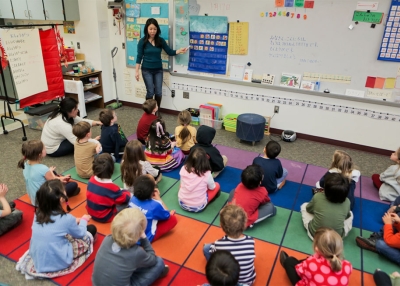What's Global about the Common Core Standards?

by Margaret Reed Millar
The Asia Society Partnership for Global Learning and the Council of Chief State School Officers (CCSSO) partnered together to define global competence and the skills and abilities that students need to demonstrate to be globally competent. CCSSO’s EdSteps initiative convened a Global Competence Taskforce composed of 24 researchers and practitioners that after 18 months of intense collaboration, defined global competence as: the capacity and disposition to understand and act on issues of global significance. This definition is expanded in a global competence matrix the Taskforce created that breaks the larger concept of global competence into the four primary capacities of globally competent students: they investigate the world, recognize perspectives, communicate ideas, and take action. Global Competence can be developed within any discipline, and cuts across disciplines.
The adoption of the Common Core State Standards (CCSS) for English language arts and mathematics in 45 states and the District of Columbia offers educators an unprecedented opportunity to marry the skill development and acquisition of core content needed to develop globally competent citizens with the rigorous skills and core content needed to prepare all students for college and careers. Further, the global competence matrix complements, and in many cases directly overlaps with, the expectations set forth for students in the Standards. In concert with clear expectations for reading, writing, speaking, listening, language and mathematics, the expectations outlined in the CCSS include the development of students’ abilities to think critically, reason, communicate effectively, and solve problems that arise in everyday life, society, and the workplace.
The adoption of new and rigorous college and career ready standards creates an historic opportunity for individual schools, districts, and states across the nation to work independently and collaboratively to rethink the curriculum, resource materials, and texts used in classroom and in online instruction. Educators across the United States are currently engaged in thoughtful discussions in their local communities about how best to make the shift to teach the Common Core State Standards through creatively adapting existing tools and resources, purchasing or creating new resources, and identifying world-class digital open educational resources. As the introduction to the English language arts Standards notes, “by emphasizing required achievements, the Standards leave room for teachers, curriculum developers, and states to determine how those goals should be reached and what additional topics should be addressed.” The time is now for schools and local communities to use the flexibility and opportunity the CCSS provide to consider instruction and curriculum that incorporates global competence into the preparation of college and career ready students.
The intersection of the CCSS and the global competence matrix can best be demonstrated through the lens of the four components of the matrix. For each, at least one example of direct intersection between the Standards and the matrix is provided, as well as suggestions for how educators may choose to embed opportunities for students to develop their global competence as part of CCSS aligned curriculum and instruction.
Investigate the World
Globally competent students investigate the world beyond their immediate environment. The CCSS for English Language Arts make clear that building research skills is integral to preparing students for the expectations of college and career, “To be ready for college, workforce training, and life in a technological society, students need the ability to gather, comprehend, evaluate, synthesize, and report on information and ideas, to conduct original research in order to answer questions or solve problems, and to analyze and create a high volume and extensive range of print and nonprint texts in media forms old and new. The need to conduct research and to produce and consume media is embedded into every aspect of today’s curriculum.” More directly, two of the College and Career Readiness Anchor Standards for Writing directly state that students must:
7. Conduct short as well as more sustained research projects based on focused questions, demonstrating understanding of the subject under investigation.
8. Gather relevant information from multiple print and digital sources, assess the credibility and accuracy of each source, and integrate the information while avoiding plagiarism.
Similarly, included in the Common Core State Standards for Mathematical Practice is the expectation that college and career ready students will be able to “construct viable arguments and critique the reasoning of others,” which includes developing abilities to “analyze situations,” “justify their conclusions,” and make “plausible arguments.” This emphasis on the ongoing and intentional development of students’ research, analysis and argumentation skills is repeated in the Investigate the World capacity defined in the global competence matrix, which calls for students to “identify and weigh relevant evidence,” to “analyze, integrate, and synthesize evidence,” and to “develop an argument based on compelling evidence…and draw defensible conclusions.” The higher-order analytic skills and research abilities that describe college and career readiness are equally a part of developing students to be globally competent citizens. Where the global competence matrix expands upon the CCSS is in an expectation that some of the research students conduct will focus on questions of global significance and that that the investigations into these researchable questions will include consultation of a variety of sources—including international sources and those sources that may exist in a non-native language. Educators looking to infuse opportunities to build global competence into a CCSS aligned curriculum may consider posing a globally relevant problem that requires the use of mathematical reasoning to develop an argument to address, or developing assignments that ask students to conduct original research into topics that have an impact beyond the local community and providing access to international sources.
Recognize Perspectives
Globally competent students recognize their own and others’ perspectives. The Common Core State Standards for English Language Arts include a series of statements that, while not directly standards themselves, offer a portrait of the capacities of literate students who meet the Standards. One of these seven statements directly addresses the importance of college and career ready students coming “to understand other perspectives and cultures.” The statement continues, “Students appreciate that the twenty-first-century classroom and workplace are settings in which people from often widely divergent cultures and who represent diverse experiences and perspectives must learn and work together. Students actively seek to understand other perspectives and cultures through reading and listening, and they are able to communicate effectively with people of varied backgrounds.” This statement directly mirrors many of the statements in the Recognize Perspectives capacity of the global competence matrix, including the expectations that students “Recognize and express their own perspective,” and “Examine perspectives of other people, groups, or schools of thought.” Where the global competence matrix expands upon the CCSS for English Language Arts document is in the expectations that a student will “identify the influences” on his or her own perspectives and on the perspectives of others, as well as “explain how cultural interactions influence situations, events, issues or phenomena.” These statements call for students to go beyond the recognition of existing differences in perspectives by conducting an analysis of the potential influences on one’s perspective and how the interaction of individuals and societies with different perspectives influences history. Educators wishing to incorporate this extension into an aligned CCSS curriculum may consider, for example, developing assignments that ask students to interview others about their perspective on a given issue, or analyze the perspective of an author or public figure, and then compare and contrast that to their own individual perspective on the given topic.
Communicate Ideas
Globally competent students communicate their ideas effectively with diverse audiences. The Common Core State Standards for English Language Arts document is replete with standards and statements that call for students to develop effective communication skills—in writing, in the creation of media, and in speaking and listening, both formally and informally. For example, one of the key features describing the Standards for Speaking and Listening is “flexible communication and collaboration,” noting that the Standards “require students to develop a range of broadly useful oral communication and interpersonal skills. Students must learn to work together, express and listen carefully to ideas, integrate information from oral, visual, quantitative, and media sources, evaluate what they hear, use media and visual displays strategically to help achieve communicative purposes, and adapt speech to context and task.” As another example, the fourth College and Career Readiness Standard for Writing asks students to “Produce clear and coherent writing in which the development, organization, and style are appropriate to task, purpose, and audience.”
Likewise, the Common Core State Standards for Mathematics require students to develop effective communications. For example, the third Standard for Mathematical Practice asks students to “Construct viable arguments” and “communicate them to others.”
The expectations for effective communications set forth in the Common Core State Standards are shared by the Communicate Ideas column of the global competence matrix, which sets the expectation that students will “communicate their ideas effectively with diverse audiences.” Where the matrix expands upon the CCSS is in the expectations that students will “recognize and express how diverse audiences may perceive different meanings from the same information” and “reflect on how effective communication affects understanding and collaboration.” Educators wishing to extend the curriculum to incorporate opportunities to build global competence in communications while maintaining alignment to the Standards may wish to facilitate discussions on how the same message can be understood differently by different individuals and groups, and ask students to reflect—either in writing or orally—about the importance of effective communication to successful collaboration with others from different backgrounds, cultures and nations.
Take Action
Globally competent students translate their ideas and findings into appropriate actions to improve conditions.
The Common Core State Standards focus on the development of the reading, writing, speaking, listening, language and mathematical skills and understandings students that research and evidence support are most essential for students to master in order to be ready for college and careers. These foundational skills and competencies lay the foundation to develop students with the capacity to take action to improve conditions in their local community, their state, the country and the world.
The Standards place an emphasis on real-world applicability of knowledge and skills, such as the fourth Standard for Mathematical Practice focused on modeling which notes that “mathematically proficient students can apply the mathematics they know to solve problems arising in everyday life, society, and the workplace.” Furthermore, an entire strand of mathematics in high school is devoted to modeling so students become adept at taking a real world situation and identifying when and how mathematics should be applied to solve a particular problem. The decision left to educators, families and communities is to determine how best to create opportunities for students to demonstrate their abilities and to take action.
Those interested in building into student learning experiences an expectation that students take action to improve conditions may consider designing extended projects to give students this opportunity. These projects may require students to identify a problem or substandard condition, assess options and plan actions based on evidence, act personally or collaboratively to execute the planned actions, assess the effectiveness of their actions, and ultimately reflect on the experience. These types of opportunities may take place within the traditional school environment, in an outside of school environment, or even at the self-direction of a student.
Margaret Reed Millar is the Senior Program Associate for Standards, Assessment, and Accountability at the Council of Chief State School Officers. Millar was a member of the Global Competence Taskforce.










